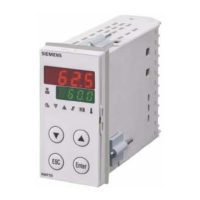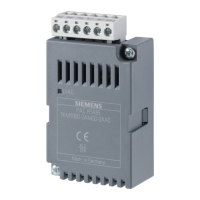72/126
Siemens Building Technologies Basic documentation RVD240 CE1P2384en
HVAC Products 18 Function block Valve actuator d.h.w. 27.05.2004
18 Function block Valve actuator d.h.w.
18.1 Operating lines
Line Function, parameter Unit
Factory
setting
Range
111 Opening time actuator of d.h.w. circuit s 35 10...873
112 Closing time actuator of d.h.w. circuit s 35 10...873
113 P-band of d.h.w. control K 35.0 1.0...100.0
114 Integral action time of d.h.w. control s 35 10...873
115 Derivative action time of d.h.w. control s 16 0...255
116 Setpoint boost d.h.w. charging K 16 0...50
117 Maximum setpoint of d.h.w. temperature °C 65 20...95
118 Setpoint boost mixing valve / heat exchanger d.h.w. K 10 0...50
119 Reduced d.h.w. setpoint for storage tank sensor at the bottom K 5 0...20
120 Circulating pump for d.h.w. charging 0 0 / 1
124 Load limit for actuation of flow switch % 25 0...60
18.2 Mode of operation
This function block provides d.h.w. temperature control with a mixing valve or 2-port
valve. The sensor and the type of actuating device required depend on the type of
plant:
Plant type Sensor Regulating unit Location of sensor and regulating unit
1–3 B71 Valve Y5 Primary return of d.h.w. heat exchanger
2–2 B3 Mixing valve Y5
1–4, 1–8,
1–9, 4–x
B3 Valve Y5
D.h.w. flow (intermediate circuit)
18.3 Control process
If the flow temperature deviates from the setpoint, the 2-port or mixing valve is adjusted
in a stepwise fashion to compensate for the deviation (with plant type 1–3, this can also
be accomplished with 2-position control). The controller drives an electric or electrohy-
draulic actuator.
The ideal running time of the actuator is 10...35 seconds.
The actuator’s opening and closing times are separately adjustable, thus making cer-
tain that actuators with asymmetric running times can also be used.
To enhance the control performance, the derivative action time (D-part of PID control)
can be adjusted, in addition to the P-band and the integral action time.
If, with plant type 1–3, no return sensor B71 is used, the function block will operate as a
2-position controller. When there is a demand for heat, 2-port valve Y5 will be fully
opened; with no demand for heat, it is fully closed. This takes place independent of
whether or not maximum limitation of the d.h.w. return temperature is activated.
18.4 Setpoint boost
Setpoint boost ensures that the flow temperature required by the consumer to perform
its function (control) will be delivered by the heat source.

